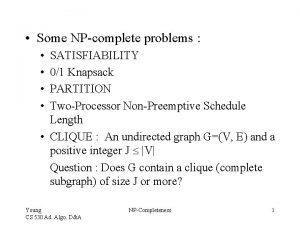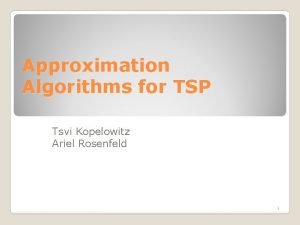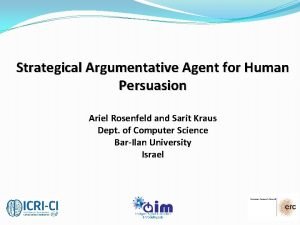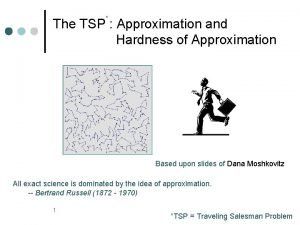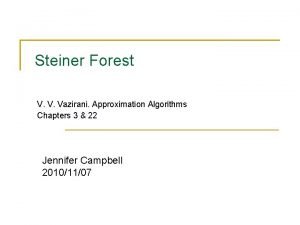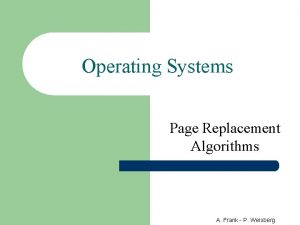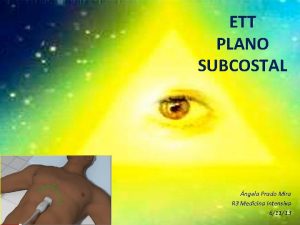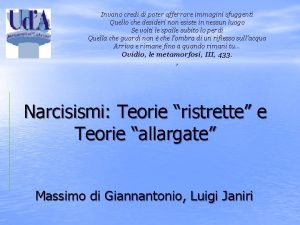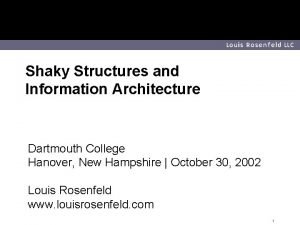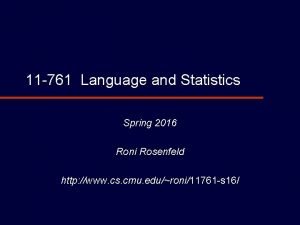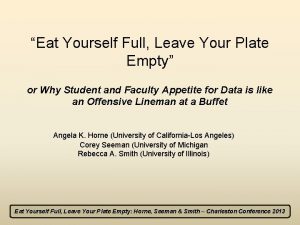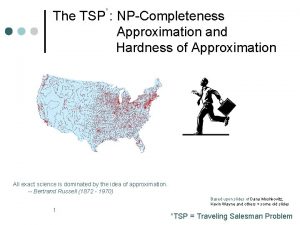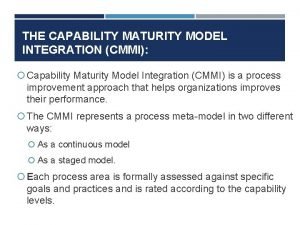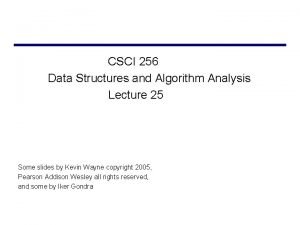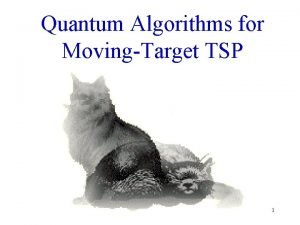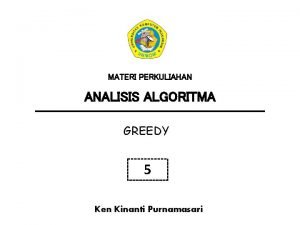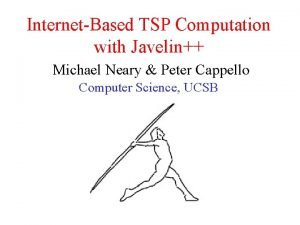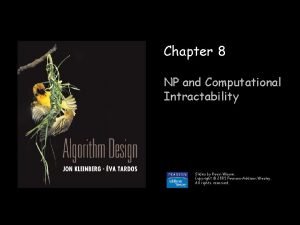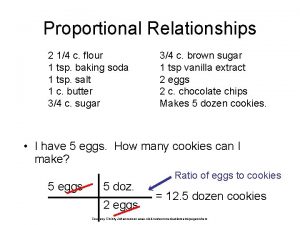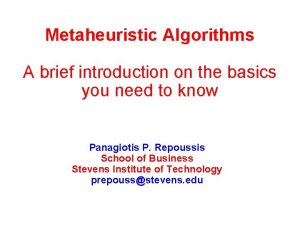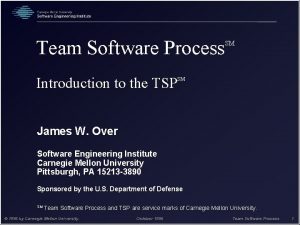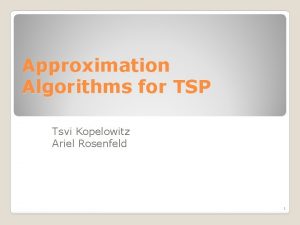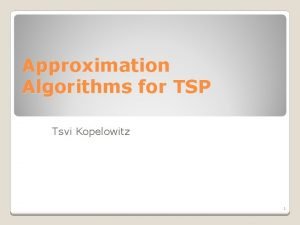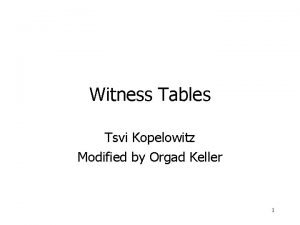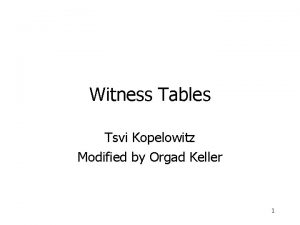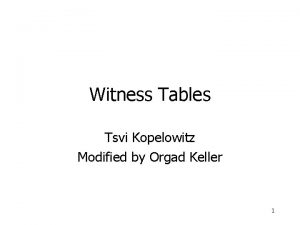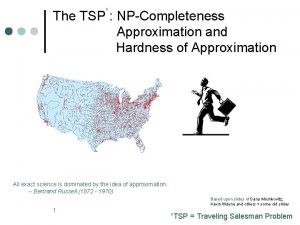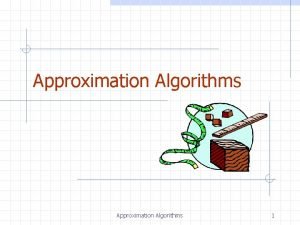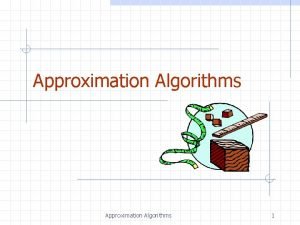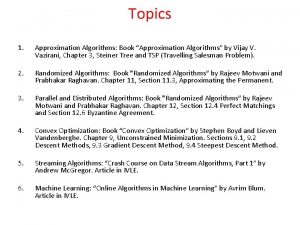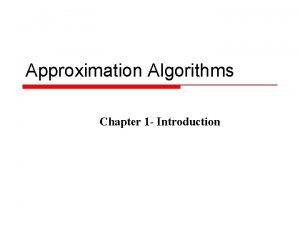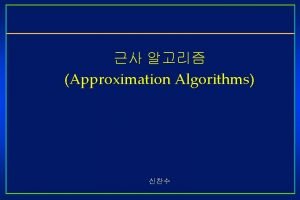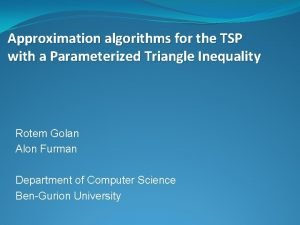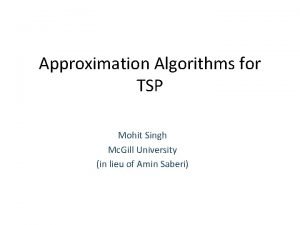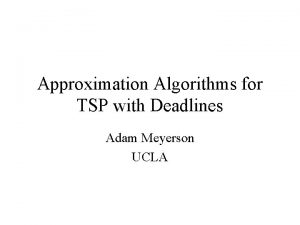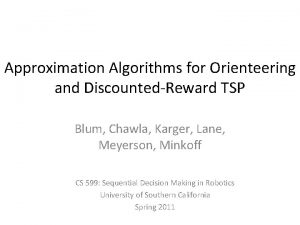Approximation Algorithms for TSP Tsvi Kopelowitz Ariel Rosenfeld






























- Slides: 30

Approximation Algorithms for TSP Tsvi Kopelowitz Ariel Rosenfeld 1

HC-Hamiltonian Cycle Input: graph G=(V, E) Output: a cycle tour in G that visits each vertex exactly once. Problem is known to be NP-Hard. 2

TSP – Traveling Salesman Problem Input: a complete graph G=(V, E) with edges of non-negative cost (c(e)). Output: find a cycle tour of minimum cost that visits each vertex exactly once. The problem is NP-Hard (reduction from HC). … and hard to approximate. 3

Hardness of Approximation Claim: For every c>1, there is no polynomial time algorithm which can approximate TSP within a factor of c, unless P=NP. 4

Proof By reduction from Hamiltonian cycle. ◦ Given a graph G, we want to determine if it has a HC. ◦ Construct a complete graph G’ with same vertices as G, where each edge e has weight 1 if it is in G, and weight c*n if it is not (n is the number of vertices). 5

Example G= 6

Example G’= 1 1 c*n 1 1 1 1 c*n c*n 1 1 c*n 7

Proof Run algorithm A for solving TSP within a factor of c. ◦ If there is a HC, TSP has a solution of weight n, and approximation is at most c*n ◦ If there is no HC, then every tour in TSP has at least one edge of weight c*n, so weight of tour is at least c*n +n-1. 8

Metric A (complete) graph with weight function w on the edges is called a metric if: ◦ For any two vertices u, v in the graph: w(u, v)=w(v, u) ◦ The Triangle Equality holds in the graph. 9

Triangle Inequality Recall: The triangle inequality holds in a (complete) graph with weight function w on the edges if for any three vertices u, v, x in the graph: Metric TSP is still NP-hard, but now we can approximate. 10

2 -approximation Given G, construct an MST T for G ◦ (since it is a metric graph, it doesn’t matter whether it is directed or not). For each edge in T create a double edge. (This will guarantee that the degrees of all the vertices are even) Find an Euler tour in the doubled T. 11

12

2 -approximation Given G, construct an MST T for G ◦ (since it is a metric graph, it doesn’t matter whether it is directed or not). For each edge in T create a double edge. (This will guarantee that the degrees of all the vertices are even) Find an Euler tour in the doubled T. Create shortcuts in the Euler tour, to create a tour. 13

2 -approximation How will we create these “shortcuts”? ◦ Traverse the Euler tour. ◦ Whenever the Euler tour returns to a vertex already visited, “skip” that vertex. The process creates a Hamiltonian cycle. 14

15

16

2 -approximation Claim: The above algorithm gives a 2 approximation for the TSP problem (in a metric graph with the triangle inequality). Proof: Definitions: OPT is the optimal solution (set of edges) for TSP. A is the set of edges chosen by the algorithm. EC is the set of edges in the Euler cycle. 17

2 -approximation Proof Continued: cost(T) cost(OPT): ◦ since OPT is a cycle, remove any edge and obtain a spanning tree. cost(EC) = 2 cost(T) 2 cost(OPT). cost(A) cost(EC) ◦ A is created by taking “shortcuts” from EC. (These are indeed shortcuts, because of the triangle inequality. ) So cost(A) 2 cost(OPT). � 18

Example d a e b f e g c b f c h Input (assume Euclidean distances) h MST 19 g

2 -approx. d a e b f e g c b f c h Walk W a b c b h b a d e f e g e d a h Hamiltonian Cycle H 20 a b c h d e f g a g

1. 5 TSP Approximation Algorithm (Known as Christofides Heuristics) Professor Nicos Christofides extended the 2. 0 TSP and published that the worst-case ratio of the extended algorithm was 3/2. 21

1. 5 Approximation Algorithm: 1. Compute MST graph T. 2. Compute a minimum-weighted matching graph M between all Odddegree vertices. 3. Combine T and M as edge set and Compute an Euler Cycle. 4. Traverse each vertex taking shortcuts to avoid visited nodes. 22

1. 5 Approximation What is a Minimum-weighted Matching? It creates a MWM on a set of the nodes having an odd degree. Why odd degree? Property of Euler Cycle (if all edges all of even-degree, EC exists) Why 1. 5 TSP? MST < Euler Cycle <= MWM+MST <= 1. 5 TSP (need to show MWM <= ½ TSP) 23

1. 5 approx. d a e b f c e g b f c h MST T h Matching M g

1. 5 -approximation Claim: The above algorithm gives a 1. 5 approximation for the TSP problem (in a metric graph with the triangle inequality). Proof: Denote: OPT, A, and EC as before. M is the set of edges in the minimum matching. 25

1. 5 -approximation Proof Continued: cost(M) cost(OPT)/2 ◦ The minimum tour on any subset B of vertices has a cost of at most cost(OPT) A Hamiltonian cycle in B can be extracted from OPT by “skipping” vertices not in B, resulting in a tour lighter than OPT, due to the triangle inequality. If B is of even size then divide the minimum tour on B into two disjoint matchings of B. The lighter matching of the two (denote by M’) has weight at most cost(OPT)/2. 26

1. 5 -approximation Proof Continued: cost(M) cost(M’) cost(OPT)/2. ◦ The number of odd vertices in a graph is even. (Always, but Why? ) ◦ Choose B to be the set of odd vertices in T. ◦ M’ is not necessarily the minimum matching of B, but cost(M) cost(M’). 27

1. 5 -approximation Proof Continued: EC is an Euler Cycle in cost(EC) cost(A) . = cost(T)+cost(M) 1. 5 cost(OPT). cost(EC) 1. 5 cost(OPT) � 28

Separating the optimal tour of B into 2 matchings e b f e g c b f c h Optimal Tour * on Odd Nodes h Matching M g

Matching d a e b f c e g b f c h G' = MST + Matching h Matching M g
 Tsvi kopelowitz
Tsvi kopelowitz Tsvi kopelowitz
Tsvi kopelowitz Tsvi kopelowitz
Tsvi kopelowitz Ariel rosenfeld
Ariel rosenfeld Tsp approximation
Tsp approximation Vazirani approximation algorithms
Vazirani approximation algorithms Lru approximation algorithm
Lru approximation algorithm Approximation algorithms for np-hard problems
Approximation algorithms for np-hard problems Plano subcostal
Plano subcostal Rosenfeld
Rosenfeld Rosenfeld narcisismo distruttivo
Rosenfeld narcisismo distruttivo Louis rosenfeld information architecture
Louis rosenfeld information architecture Meni rosenfeld
Meni rosenfeld Roni rosenfeld
Roni rosenfeld Rosenfeld library ucla
Rosenfeld library ucla Traveling salesman problem
Traveling salesman problem Tsp 1000
Tsp 1000 Cmmi maturity model
Cmmi maturity model Tsp
Tsp Tsp
Tsp Tsp vs brs
Tsp vs brs Frnti
Frnti Kevin buchin
Kevin buchin Tsp greedy
Tsp greedy Ucsb tsp
Ucsb tsp Wvng hro
Wvng hro Tsp
Tsp Coules
Coules Tablespoon abbreviation cooking
Tablespoon abbreviation cooking Tabu search tsp
Tabu search tsp Tsp business software
Tsp business software
